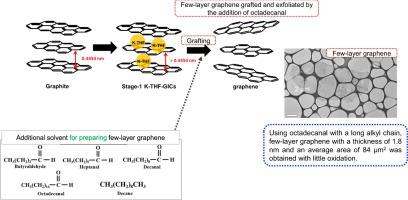Our official English website, www.x-mol.net, welcomes your feedback! (Note: you will need to create a separate account there.)
Preparation of grafted few-layer graphene from K-THF-Graphite intercalation compounds by the addition of aldehyde
FlatChem ( IF 6.2 ) Pub Date : 2020-11-01 , DOI: 10.1016/j.flatc.2020.100206 Yoshihisa Nanri , Takuya Wada , Hirosi Yoshitani , Hiroji Fukui , Akira Nakasuga , Tomoki Tsumura , Masahiro Toyoda
FlatChem ( IF 6.2 ) Pub Date : 2020-11-01 , DOI: 10.1016/j.flatc.2020.100206 Yoshihisa Nanri , Takuya Wada , Hirosi Yoshitani , Hiroji Fukui , Akira Nakasuga , Tomoki Tsumura , Masahiro Toyoda

|
Abstract The preparation of graphene with large area, few layers, and without oxidation is required. Thus far, we have determined that by synthesizing graphite intercalation compounds (GICs) and adding water to them, it was possible to prepare few-layer graphene without oxidation; however, its area was small. Therefore, we investigated the addition of aldehyde (with different alkyl chain lengths containing electron-withdrawing groups, which allowed the use of an electrophilic addition reaction on carbon hexagonal layers) to GICs to prepare few-layer graphene with a large area and without oxidation. In this study, stage-1 ternary graphite intercalation compounds (K-THF-GICs) were synthesized using the solution method. Aldehyde solvents with different alkyl chain lengths were then added to K-THF-GICs, and the mixtures were stirred for 72 h. An attempt was made to prepare few-layer, small-area graphene with little oxidation. Results indicated that the addition of aldehyde containing an electron-withdrawing group to GICs promoted exfoliation with the electrophilic addition reaction on the carbon hexagonal layer, producing few-layer graphene. UV–vis (Ultraviolet・Visible Absorption Spectroscopy) results showed that solvents with long alkyl chains were more suitable for preparing few-layer graphene than solvents with short alkyl chains. According to Raman spectroscopy, X-ray photoelectron spectroscopy, and transmission electron microscopy, graphene exfoliated by decanal or octadecanal as three and two layers, respectively, was minimally oxidized and showed an area of several tens of μm2. Comparative analysis of the heat treatment of few-layer graphene demonstrated that it was possible to graft few-layer graphene exfoliated using decanal or octadecanal. Such grafting may be involved in exfoliation. Few-layer graphene was then prepared by adding an aldehyde solvent containing long alkyl chains to K-THF-GICs. Using octadecanal containing the longest alkyl chain among the solvents tested in this study, few-layer graphene with a thickness of 1.8 nm and an average area of 84 µm2 was obtained with little oxidation.
中文翻译:

K-THF-石墨插层化合物加醛制备接枝少层石墨烯
摘要 需要制备大面积、少层数、无氧化的石墨烯。到目前为止,我们已经确定通过合成石墨插层化合物 (GIC) 并在其中加水,可以在不氧化的情况下制备少层石墨烯;然而,它的面积很小。因此,我们研究了醛(具有不同的烷基链长度,含有吸电子基团,允许在碳六方层上使用亲电加成反应)添加到 GIC 中以制备大面积且无氧化的少层石墨烯。在本研究中,使用溶液法合成了第一阶段三元石墨插层化合物 (K-THF-GIC)。然后将具有不同烷基链长度的醛溶剂加入到 K-THF-GIC 中,并将混合物搅拌 72 小时。尝试制备少氧化的少层、小面积石墨烯。结果表明,将含有吸电子基团的醛添加到 GIC 中,通过碳六方层上的亲电加成反应促进剥离,产生少层石墨烯。UV-vis(紫外·可见吸收光谱)结果表明,长烷基链的溶剂比短烷基链的溶剂更适合制备少层石墨烯。根据拉曼光谱、X 射线光电子能谱和透射电子显微镜,被癸醛或十八醛分别剥离为三层和两层的石墨烯被最小程度地氧化,并显示出几十 μm2 的面积。对少层石墨烯热处理的比较分析表明,可以接枝使用癸醛或十八醛剥离的少层石墨烯。这种嫁接可能涉及剥落。然后通过向 K-THF-GIC 添加含有长烷基链的醛溶剂来制备少层石墨烯。使用本研究中测试的溶剂中含有最长烷基链的十八烷,获得了厚度为 1.8 nm、平均面积为 84 µm2 的少层石墨烯,几乎没有氧化。
更新日期:2020-11-01
中文翻译:

K-THF-石墨插层化合物加醛制备接枝少层石墨烯
摘要 需要制备大面积、少层数、无氧化的石墨烯。到目前为止,我们已经确定通过合成石墨插层化合物 (GIC) 并在其中加水,可以在不氧化的情况下制备少层石墨烯;然而,它的面积很小。因此,我们研究了醛(具有不同的烷基链长度,含有吸电子基团,允许在碳六方层上使用亲电加成反应)添加到 GIC 中以制备大面积且无氧化的少层石墨烯。在本研究中,使用溶液法合成了第一阶段三元石墨插层化合物 (K-THF-GIC)。然后将具有不同烷基链长度的醛溶剂加入到 K-THF-GIC 中,并将混合物搅拌 72 小时。尝试制备少氧化的少层、小面积石墨烯。结果表明,将含有吸电子基团的醛添加到 GIC 中,通过碳六方层上的亲电加成反应促进剥离,产生少层石墨烯。UV-vis(紫外·可见吸收光谱)结果表明,长烷基链的溶剂比短烷基链的溶剂更适合制备少层石墨烯。根据拉曼光谱、X 射线光电子能谱和透射电子显微镜,被癸醛或十八醛分别剥离为三层和两层的石墨烯被最小程度地氧化,并显示出几十 μm2 的面积。对少层石墨烯热处理的比较分析表明,可以接枝使用癸醛或十八醛剥离的少层石墨烯。这种嫁接可能涉及剥落。然后通过向 K-THF-GIC 添加含有长烷基链的醛溶剂来制备少层石墨烯。使用本研究中测试的溶剂中含有最长烷基链的十八烷,获得了厚度为 1.8 nm、平均面积为 84 µm2 的少层石墨烯,几乎没有氧化。


























 京公网安备 11010802027423号
京公网安备 11010802027423号